Help the steppes. Mongols are loyal allies of the USSR in the Great Patriotic War
The first brotherly state
Up to the end of the 1940-s, Mongolia and another small state - the Tuvan people's republic, which later became part of the RSFSR, remained the only true allies of the Soviet Union. This was explained by the fact that with the direct participation of Soviet Russia in both Central Asian states, people's democratic governments oriented towards the socialist path of development came to power. Of course, it was very difficult to modernize the extremely backward, living in medieval feudal, and in some places tribalism, Mongolia and Tuva. But the Soviet Union provided local progressive figures in this invaluable support. In turn, Mongolia and Tuva became strongholds of Soviet influence in Central Asia. At the same time, larger Mongolia performed an important task of a buffer between the territory of the USSR and China, in which there was actually no single statehood at that time, and the territories controlled by hostile Japan were near the Soviet borders. Another 12 March 1936 between the Soviet Union and the Mongolian People's Republic was signed a Protocol on mutual assistance. When the armies of Japan and the puppet state of Manchukuo invaded 1939 on the territory of Mongolia, the 1-I army group, commanded by George Zhukov, came out on the side of the Mongolian People's Republic. As a result of the fighting on the Khalkhin-Gol River, the Red Army and the Mongolian People’s Revolutionary Army (INRA) were able to defeat the Japanese and Manchurian troops. Meanwhile, back in the summer of 1938, Soviet and Japanese troops clashed in battles at Lake Hassan.
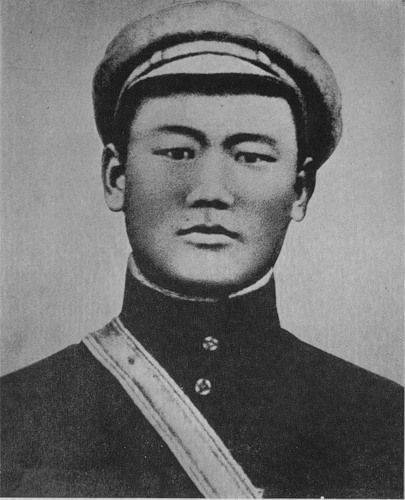 History Soviet-Mongolian military friendship goes into a more distant past - in the turbulent years of the Civil War in Russia itself. In fact, the people's revolution in Mongolia in 1921 won with the direct support of Soviet Russia, which provided comprehensive assistance to the Mongolian revolutionaries. In 1920, anti-Chinese groups operating in Urga, which included Suhe-Bator (pictured) and Choibalsan - the future leaders of the Mongolian revolution, came into contact with the Russian Bolsheviks. Under the influence of the Bolsheviks 25 June 1920, the Mongolian People’s Party was created. 19 August 1920 The Mongol revolutionaries went to Irkutsk, where they received assurances of support from Soviet Russia in exchange for the creation of a people's government in Mongolia. After that, Sukhbaatar and Choibalsan remained in Irkutsk, where they underwent military training under the leadership of the Bolsheviks. Thus, the leaders of the Mongolian revolution were actually the first Mongolian military trained in Soviet Russia. Sukhe-Bator himself already had the experience of military service with the rank of sergeant in the machine-gun squadron of the old Mongolian army, and Choibalsan was in the past a monk and a simple laborer. In early February, 1921, the city of Choibalsan, and another revolutionary, Chagdarzhav, returned to Urga. On February 9, Suhe-Bator was appointed commander-in-chief of the Mongolian revolutionary army, and he began recruiting tsirik soldiers among Mongolian pastoralists - arats. February 20 began clashes with a few Chinese units. The Provisional Government of the Mongolian People’s Republic was formed, in which the status of Sukhe Bator as commander-in-chief was also confirmed. March 18 The number of young Mongolian army increased to 400 soldiers and commanders, fighting began with the Chinese troops.
History Soviet-Mongolian military friendship goes into a more distant past - in the turbulent years of the Civil War in Russia itself. In fact, the people's revolution in Mongolia in 1921 won with the direct support of Soviet Russia, which provided comprehensive assistance to the Mongolian revolutionaries. In 1920, anti-Chinese groups operating in Urga, which included Suhe-Bator (pictured) and Choibalsan - the future leaders of the Mongolian revolution, came into contact with the Russian Bolsheviks. Under the influence of the Bolsheviks 25 June 1920, the Mongolian People’s Party was created. 19 August 1920 The Mongol revolutionaries went to Irkutsk, where they received assurances of support from Soviet Russia in exchange for the creation of a people's government in Mongolia. After that, Sukhbaatar and Choibalsan remained in Irkutsk, where they underwent military training under the leadership of the Bolsheviks. Thus, the leaders of the Mongolian revolution were actually the first Mongolian military trained in Soviet Russia. Sukhe-Bator himself already had the experience of military service with the rank of sergeant in the machine-gun squadron of the old Mongolian army, and Choibalsan was in the past a monk and a simple laborer. In early February, 1921, the city of Choibalsan, and another revolutionary, Chagdarzhav, returned to Urga. On February 9, Suhe-Bator was appointed commander-in-chief of the Mongolian revolutionary army, and he began recruiting tsirik soldiers among Mongolian pastoralists - arats. February 20 began clashes with a few Chinese units. The Provisional Government of the Mongolian People’s Republic was formed, in which the status of Sukhe Bator as commander-in-chief was also confirmed. March 18 The number of young Mongolian army increased to 400 soldiers and commanders, fighting began with the Chinese troops. 10 April 1921 Central Committee of the Mongolian People’s Party and the Provisional Government of the MPR appealed to the Council of People’s Commissars of the RSFSR with a request to provide military assistance in the fight against the retreating into the territory of Mongolia detachments of "white". So began the cooperation of the Soviet and Mongolian armies. The Red Army, the Mongol formations, the People’s Revolutionary Army of the Far Eastern Republic acted jointly against the Chinese militarists, the Asian division of Baron R. Ungern von Sternberg and smaller groups. The Asian division of Baron Ungern did not succeed in storming Kyakhta - the young Mongolian army defeated the units of the baron who suffered heavy losses, and he was forced to go back to Buryatia. Soon the division of Ungern was defeated, and he himself was captured by the Mongols and then by the red partisans of PG G. Shchetinkina. On June 28, Soviet-Mongolian troops entered Mongolia, and on July 6 captured the capital of Mongolia Urga without a fight. Later, Soviet military specialists helped the Mongolian command in organizing and training the first regular units of the revolutionary army. In fact, the Mongolian People’s Revolutionary Army was created with the direct participation of Soviet military advisers and specialists. Thus, the first two years of the existence of the Mongolian army, its General Headquarters were headed by Soviet military specialists Ljatte, P.I. Litvintsev, V.A. Huwa, S.I. Popov.
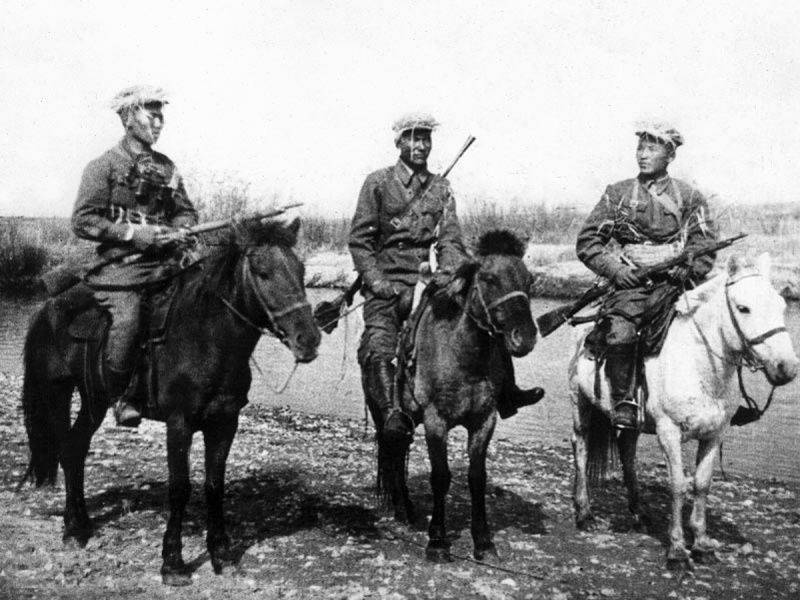
- cavalrymen of the Mongolian People’s Revolutionary Army
After the defeat of the whites and the ousting of the Chinese troops from Mongolia, the young people's republic had a new serious opponent. The northeastern part of China, weakened by internal contradictions, was occupied by Japan. On the territory of a number of provinces, a puppet state of Manchukuo headed by Emperor Pu Yi, who claimed legitimate authority in all of China, was created. In Inner Mongolia, the state of Mengjiang was created, which was also actually under the complete control of Japan. Both states and the Japan behind them were fierce opponents of the Mongolian People’s Republic. The Japanese and Manchu troops constantly carried out provocations on the border with the Mongolian People's Republic, "breaking through" the level of border protection. Throughout 1932-1935. conflicts in the border zone were constant, several dozen Mongolian soldiers and commanders received military awards for valor displayed in battles with Japanese and Manchurian troops. Pilot D. Demberel and Jr. Commander S. Gongor received the country's highest award — the title of Hero of the Mongolian People's Republic. The need to protect the state interests of the MPR was dictated by the signing of the Protocol on Mutual Assistance between the Mongolian People's Republic and the USSR in 1936. The Soviet Union also assisted the Mongolian army in the training of personnel, supplied the Mongolian troops with weapons and ammunition. So, in 1936, Mongolia began to receive Soviet-made armored cars. In the first installment came 35 BA-6 and FAI 15. After this, the creation of a Mongolian armored brigade began, and an armored squadron from the 9 BA and 9 FAI was included in the composition of each cavalry division of the INRA.
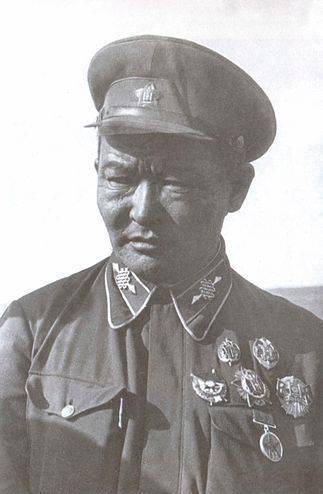
As soon as Hitler's Germany and its 22 allies on June 1941 committed aggression against the Soviet Union, unleashing a war, a joint meeting of the Presidium of the Central Committee of the Mongolian People’s Revolutionary Party, the Presidium of the Small State Khural of the MPR and the Council of Ministers of the MPR took place on the same day. It was decided to express the unequivocal attitude of the Mongolian government, the people of Mongolia to the beginning of the aggressive war of Nazi Germany and its allies against the Soviet state. The meeting decided to confirm the commitments made by Mongolia in accordance with the Protocol on Mutual Assistance between the MPR and the USSR of 12 in March 1936. The most important task of the Mongolian people and the state was to assist the Soviet Union in the fight against Hitler Germany. It was stressed that only a victory over fascism could ensure the further freedom and effective development of Mongolia. It should be noted that this statement of the Mongolian leadership was far from declarative in nature. Almost immediately, real practical actions of Mongolia and its citizens in support of the Soviet Union followed.
Everything for the front, everything for victory
In September, 1941 was formed by the Central Commission under the MPR government, such commissions were established in each aimak of the country. Their tasks included the organization of work to provide assistance to the Soviet Red Army fighting against the fascist invaders. Across Mongolia, began a massive wave of donations to the aid funds of the Red Army. Many ordinary Mongols, workers and herdsmen, literally carried the last of their modest reserves. After all, the population of Mongolia and so did not have a high standard of living. At the call of the government of the Mongolian People's Republic, brigades for the procurement of fur and meat were established in aimaks. Warm clothes and meat products were sent to the Soviet Union - to transfer the fighting parts of the Red Army. The Mongolian workers also worked after the end of the work shift, the pastoralists transferred meat and wool. That is, all representatives of the working people of Mongolia made a contribution to the collection of assistance for the fighting Red Army. It should be noted that this assistance was of great importance for the replenishment of food and clothing stocks of the Red Army, the organization of its medical support. But the main thing is that it demonstrated the nationwide solidarity of the Mongols in supporting the Soviet people, who are waging a bloody war against the fascist invaders.
In October, 1941 from Mongolia sent the first echelon formed by the citizens of the country with gifts to the soldiers of the Red Army. He was carrying 15 thousands of sets of winter uniforms, about three thousand individual gift packages for a total of 1,8 million tugriks. In addition, the State Bank of the USSR received 587 thousand tugriks in cash for expenditure needs. In the first three years of the war, eight echelons were sent from Mongolia to the Soviet Union. They delivered food, uniforms and other necessary items for a total of 25,3 million tugriks. The last ninth echelon of 127 carriages was shipped at the start of 1945. Here is an exemplary list of deliveries delivered by only one of the echelons - in November 1942 G.: short fur coats - 30 115 units; felt boots - 30 500 pairs; fur mittens - 31 257 pairs; fur vests - 31 090; soldier belts - 33 300 pcs .; woolen sweatshirts - 2 290 pcs .; fur blankets - 2 011; berry jam - 12 954 kg; carcasses of gazelle - 26 758 pcs .; meat - kg 316 000; individual parcels - 22 176; Sausage - 84 800 kg; oil - 92 000 kg. (Semenov A.F., Dashtseren B. Squadron “Mongolian Arat.” - M., Voenizdat, 1971).
The general secretary of the Central Committee of the MPRP, Yu. Tsedenbal, in his report at the meeting of the party activists of the city of Ulaanbaatar, 6 of October, 1942, said: “It is necessary to understand and explain to every working people of the Mongolian People's Republic that only the defeat of Hitlerism will save our country from the threat of military attack, from all those horrors that the nations of the warring countries are experiencing now, that everything we can, we must give to achieve this goal, without which no minute well-being would be durable ”(quoted in Semenov A.F., Dashtseren B. Squadron“ Mongolian arat ". - M., Military Publishing, 1971). And the people of Mongolia have heeded this call from the leadership of the party and the state, sharing the latter in order to help the front. So, many arats transferred their monthly or even annual earnings to help the front, they gave a significant part of the livestock and horses.
In the autumn of 1942, a camel caravan left the city of Khovd. The caravan was unusual. Firstly, it was the largest in the history of the Great Silk Road and totaled 1200 camels. Secondly, he carried things very necessary for the warring Red Army. Thoughtfully sewn by Mongolian women 5 thousand jerseys and 10 thousand short fur coats, 22 thousand pairs of socks and mittens made of camel hair, seven tons of dried meat, construction materials tank "T-34" - all this was collected by the nomads of the steppe country for the Red Army. The caravan had to go a very difficult way - almost a thousand kilometers through the semi-desert, mountains, overcoming the Chuysky tract. The final destination of the caravan was Biysk. The caravan was led by 19-year-old B. Luvsan, the commander of the Komsomol detachment, who was instructed to accompany the cargo. In November 1942, the caravan left Khovd. At the Chike-Taman pass, several dozen camels fell into the abyss. They went to Biysk for almost three months, only occasionally meeting the nomads of local residents - Oirats, who helped travelers with food, nursed frozen and sick guides of the caravan.
B. Luvsan recalled: “In the winter of 1942, we were warmly welcomed in the Oirot Autonomous Region,” the source said. “We were invited into houses, into yurts, fed, poured tea, accompanied, helped to look after camels, from which they were not removed even during the nights. . In the winter of 1942, there were hard frosts. Temperature minus 30 degrees was considered a thaw. Residents of Gorny Altai gave us the last, so that we only reached Biysk. I still keep the bell that hung around the neck of a large camel. For me and my family, this is a great relic. During the movement of the caravan, we sang a folk song "Sylen Boor." She has a lot of verses and was told in her about friendship, love, loyalty and devotion "(Quoting Navanzoooch Tsedev, Dashdorzh Munkhbat. Mongolia - the Red Army during the Great Patriotic War // World of Eurasia).
It was only in February 1943 that the caravan reached its destination. He went back through 10 days. Despite the war, grateful Soviet citizens outfitted him with flour, wheat, and vegetable oil — those goods that were in short supply in Mongolia and which the nomads really needed. B. Luvsan received the title of Hero of the Mongolian People's Republic for his leadership of this extremely dangerous transition.
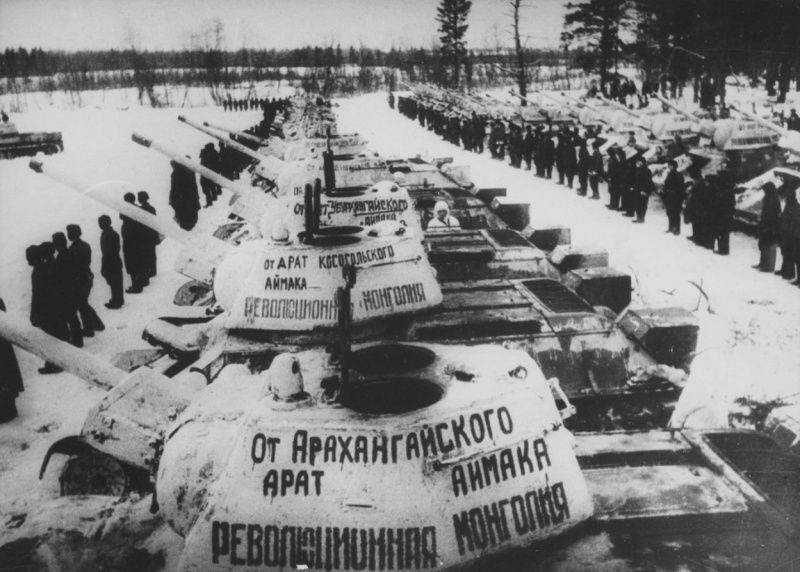
Tank column "Revolutionary Mongolia"
But even more valuable was the contribution of Mongolia to providing the belligerent Red Army with weapons and horses. 16 January 1942 was announced to raise funds for the acquisition of tanks for a tank column. Thanks to voluntary donations of citizens of Mongolia, 2,5 million tugriks, 100 thousand US dollars, 300 kg were transferred to Vneshtorgbank. gold products. The collected funds were purchased 32 tank T-34 and 21 tank T-70. Thus, the column “Revolutionary Mongolia” was formed, for the transfer of which the Red Army 12 on January 1943 to the region of Naro-Fominsk of the Moscow region arrived representatives of the command of the Mongolian People’s Revolutionary Army led by Marshal Khorlogiy Choibalsan. The transferred tanks had personal names: “Bolshoi Khural”, “From the Small Khural”, “From the Council of Ministers of the MPR”, “From the Central Committee of the MPRP”, “Sukhe Bator”, “Marshal Choibalsan”, “Khatan-Bator Maksarzhav”, “Mongolian Chekist "," Mongolian arat "," From the intelligentsia of the Mongolian People's Republic "," From the Soviet citizens in the Mongolian People's Republic ".
The Mongolian delegation carried out the transfer of a tank column "Revolutionary Mongolia" to the command of the 112-th Red Banner Tank Brigade. This compound was 2 in January 1942 was formed instead of the 112 Panzer Division, which fought heroically in the battles for Tula, for Moscow, and lost much of the tanks, guns and personnel. At the same time, the brigade retained the number designation of the abolished division, and the battalions of the brigade kept the names of the regiments that were part of the division. By the way, in addition to the tanks, the Mongolian delegation brought 237 food and stuff wagons for the Red Army. 1 thousand tons of meat, 90 tons of butter, 80 tons of sausages, 150 tons of confectionery, 30 thousand short fur coats, 30 000 pairs of felt boots, 30 000 fur tops were delivered. October 30 1943. By the Decree of the Presidium of the Supreme Soviet of the USSR "For the excellent performance of command assignments and the heroism shown by personnel in battles with the German fascist invaders" the 112 Tank Brigade was renamed the 44 Tank Guards Red Banner Tank Brigade. Mongolia". By the way, until the end of the war, Mongolia provided the brigade with full food and clothing allowance at its own expense.
Squadron "Mongolian arat"
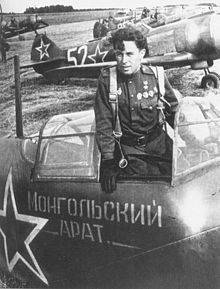 Mongolia also contributed to equipping the Soviet military aviation. In 1943, the collection of funds of citizens of the MPR for the acquisition of an aviation squadron, which was called the Mongolian Arat, began. 2 million Tugriks were transferred for the purchase of aircraft in July 1943. On August 18, I.V. Stalin personally expressed gratitude to the leadership of the Mongolian People’s Republic for their assistance in forming the squadron: “To the Prime Minister of the MPR, Marshal Choibalsan. On behalf of the Soviet Government and my own, I express my heartfelt gratitude to you, and in your person, to the government and people of the Mongolian People’s Republic, who have collected two million Tugriks for the construction of the Mongolian Arat combat aircraft squadron for the Red Army, waging a heroic struggle against the Nazi invaders. The desire of the MPR workers to build a squadron of Mongolian Arat combat aircraft will be fulfilled. I. Stalin, August 18, 1943 " (Semenov A.F., Dashtseren B. Squadron "Mongolian arat". - M., Military Publishing House, 1971).
Mongolia also contributed to equipping the Soviet military aviation. In 1943, the collection of funds of citizens of the MPR for the acquisition of an aviation squadron, which was called the Mongolian Arat, began. 2 million Tugriks were transferred for the purchase of aircraft in July 1943. On August 18, I.V. Stalin personally expressed gratitude to the leadership of the Mongolian People’s Republic for their assistance in forming the squadron: “To the Prime Minister of the MPR, Marshal Choibalsan. On behalf of the Soviet Government and my own, I express my heartfelt gratitude to you, and in your person, to the government and people of the Mongolian People’s Republic, who have collected two million Tugriks for the construction of the Mongolian Arat combat aircraft squadron for the Red Army, waging a heroic struggle against the Nazi invaders. The desire of the MPR workers to build a squadron of Mongolian Arat combat aircraft will be fulfilled. I. Stalin, August 18, 1943 " (Semenov A.F., Dashtseren B. Squadron "Mongolian arat". - M., Military Publishing House, 1971). The transfer of 12 aircraft La 5 squadron to the Soviet command took place at a field airfield at Vyazovaya station, which in the Smolensk region, 25 September 1943 Squadron "Mongolian arat" became part of the 2-th Guards regiment of the 322 fighter air defense unit The first commander of the squadron "Mongolian arat" became the Hero of the Soviet Union guard captain N.P. Pushkin. Deputy Squadron Commander was Guards Senior Lieutenant N. Ya. Zenkovich, adjutant of the squadron - Guards Lieutenant MG Rudenko. The technical staff was represented by senior technicians of the guard, senior technician-lieutenant F.I. Glushchenko and the guard technician-lieutenant N.I. Kononov. The flight commander was Guards Senior Lieutenant G.I. Bessolitsyn, technician level - Guards senior technician-lieutenant N.I. Kalinin, senior pilots - guards junior lieutenants A.P. Kalinin and M.E. Ryabtsev, pilots - M.V. Baranov, A.V. Davydov, A.E. Dmitrievsky, A.I. Zolotov, L.M. Masov, A.S. Subbotin, V.I. Chumak. The squadron showed itself at the height, in fact confirming the high combat capability and meeting the hopes of the citizens of Mongolia who participated in the fundraising for its creation. Until the victory itself, as in the case of the tank column, the leadership of the Mongolian People's Republic was engaged in food and clothing support of the squadron. Warm clothes, meat, butter, sweets - all this was transferred to the fighters from the Mongolian herders.
Five hundred thousand horses
Invaluable was the contribution of Mongolia to the supply of horses to the Red Army. In fact, only Mongolia, with the exception of the Soviet Union itself, assisted the Red Army with horses. It should be noted that, apart from the Soviet Union itself, there was nowhere to take horses for the needs of the Red Army except in Mongolia. Moreover, in such quantities as were required by the front. First, only the United States possessed similar horse resources. Secondly, their delivery from the USA was practically impossible due to the excessive complexity of transportation and the impossibility in a capitalist country to organize their purchase from private owners at cheap prices. So Mongolia became the main supplier of horses for the Red Army.
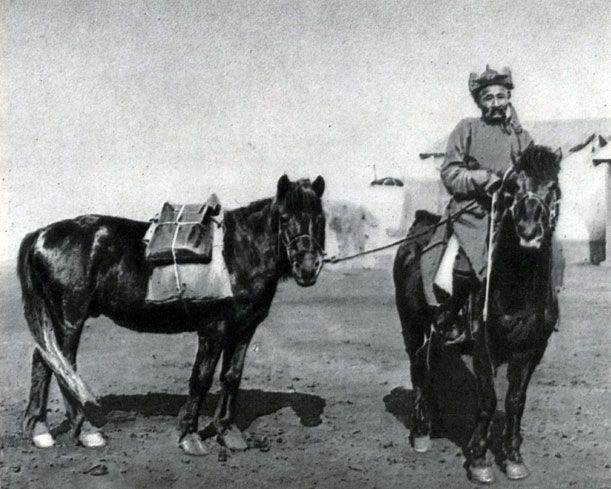
The first deliveries of horses, the quantity and quality of which Mongolia was famous for, began at the end of 1941. Since March 1942, the state organized the purchase of horses at specially set state prices. During the war years more than 500 thousand horses were delivered from Mongolia to the Soviet Union. In addition, 32 thousands of horses (a quantity sufficient to recruit 6 cavalry divisions by wartime states) were delivered to the Soviet Union as gifts from the farms of Mongolian herdsmen. Thus, every fifth horse of the Red Army was supplied by Mongolia. These were small horses of the Mongolian breed, distinguished by great endurance, unpretentiousness in food and “self-sufficiency” - they fed themselves, pinching grass and nibbling the bark of trees. General Issa Pliev recalled that "... an unpretentious Mongol horse near the Soviet tank reached Berlin".
Food aid to the Red Army, provided by a small population and economically weak Mongolia, was almost equal to food supplies from the United States. If the American side delivered 665 thousand tons of canned food to the Soviet Union, Mongolia gave 500 thousand tons of meat to the front. As we can see, the numbers are almost equal, only the scales of the American and Mongolian economies are completely incomparable. A huge role in the provision of the Red Army was played by the supply of wool from Mongolia. They even blocked the delivery of similar products from the United States — if 54 had sent thousands of tons of wool from the United States, then Mongolia had sent 64 of thousands of tons of wool. Naturally, such large-scale food supplies and things demanded tremendous strain on the Mongolian economy. The labor resources of the Mongolian People’s Republic were fully utilized. In Mongolia, a ten-hour working day was officially introduced. A huge part of the livestock population was withdrawn by the state for the support of the allied Soviet state. Thus, during the entire period of the Great Patriotic War, Mongolia provided essential and invaluable assistance to the fighting Red Army and the Soviet people. But still, the main contribution of Mongolia to the Second World War occurred after the victory over Nazi Germany. We are talking about the war with Japan, in which the Mongolian People’s Republic took an active part.
Mongolian army in the war with Japan
Since from the very beginning of the Great Patriotic War there was a huge risk of Japan attacking the Soviet Union, the Soviet leadership was forced to keep a million troops in the Far East and Eastern Siberia. These forces could be used to repel the aggression of Hitler’s Germany, but they were located in the Far East and Eastern Siberia. The role of auxiliary armed forces in this situation was assigned to the Mongolian People’s Revolutionary Army. In the event of aggression by militarist Japan, the INRA was to play a very important role in supporting the Far Eastern forces of the Red Army. Therefore, the Mongol leadership in 1941-1944. the strength of the country's armed forces has been quadrupled. When the General Staff of the INRA was created on the Soviet model of control of the armed forces - tank, mechanized, artillery, aviation, medical and veterinary services. In October, the Sukhe Bator Officer School opened in Mongolia in 1943. September 8 1942. 110 citizens of Mongolia were admitted to the higher schools of the Red Army, a number of Mongolian citizens went to study in the cavalry military schools of the NKVD of the USSR. 10 senior officers of the INRA were sent to training at the Military Academy. Mv Frunze.
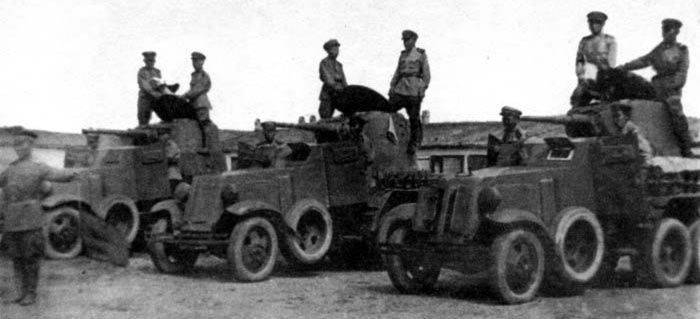
Defense spending increased significantly, military training of the population proceeded at an accelerated pace. A law was passed on universal conscription, which extended to all men and even women in Mongolia. These measures of the Mongolian leadership allowed several Soviet divisions to be withdrawn from the Far East and transferred to the European part of the USSR, against the Nazi invaders. When Hitler's Germany and its European allies were defeated, Japan remained - the last member of the Axis who fought in the Asia-Pacific region against British, American, Australian and New Zealand troops. In February, 1945, I.V. At the Yalta Conference, Stalin promised to declare war on Japan two to three months after the final defeat of Nazi Germany. Stalin kept his promise. 8 August 1945, exactly three months after the Great Victory, the Soviet Union declared war on Japan.
However, preparation for hostilities in the Far East began much earlier. Back in May, the 1945 of the USSR began the transfer of significant military contingents to the Far East. From May to early August, troops with a total strength of over 400 thousands of troops, 7137 artillery guns and mortars, 2119 tanks and self-propelled artillery units were deployed to the Far East. Three fronts were formed - the Trans-Baikal as part of the 17, 36, 39 and 53 armies, 6 of the Guards Tank Army, cavalry-mechanized group of the Soviet-Mongolian troops, 12-th Air Army and the air defense forces; 1 of the Far East as part of the 35, 1 of the Red Banner, 5 and 25 of the Army, Chuguev Operative Group, 10 of the Mechanized Corps, 9 of the Air Force, Primorye Air Defense Army; The 2 th Far East in the 2 th Red Banner, 15 th and 16 th armies, 5 th separate rifle corps, 10 th Air Army, Amur Air Defense Army. The Trans-Baikal Front was commanded by Marshal R.Ya. Malinovsky, 1-m Far Eastern - Marshal KA Meretskov, 2-m Far Eastern - Marshal A.M. Vasilevsky. The Mongolian People’s Revolutionary Army, commanded by Marshal H. Choibalsan, was to take the side of the Soviet Union. 10 August 1945, the Mongolian government declared war on Japan. Mobilization has affected almost everything that can wear weapon the male population of Mongolia. Virtually every Mongolian man of working age was drafted into the army — even the Soviet Union of World War II did not know such mobilization.
Mongolian troops became part of the Horse-mechanized group of the Trans-Baikal Front, commanded by Colonel-General Issa Alexandrovich Pliev. The chief of staff of the group was Major General Viktor Nikiforov. The Mongolian command was represented by two generals — the deputy commander for Mongolian troops was Lieutenant-General Jamian Lhagvasuren, and the head of the political department of the Mongolian troops was Lieutenant-General Yumzhagiin Tsedenbal. Mongolian Connection mechanized cavalry group included 5-yu, 6-yu, 7-yu and 8-Cavalry Division of the Mongolian People's Revolutionary Army, 7-th motobronebrigadu MNRA, 3-th separate tank regiment and 29-th Artillery Regiment INRA. The total number of equestrian mechanized connections of the INRA consisted of 16 thousands of troops. They were consolidated into 4 cavalry and 1 aviation division, motorized armored brigade, tank and artillery regiments, communications regiment. In service was the 32 light tank and 128 artillery shells. In addition to a horse-mechanized group of over 60, thousands of Mongolian military personnel were mobilized to the front, the rest of the forces were in the country. 200 soldiers and officers of the INRA were killed during the Manchurian operation. For the difference in the hostilities, three servicemen received the title of Hero of the Mongolian People's Republic: private machine gunner Ayuush Luvsantsehraniin was awarded posthumously, stars also received major Samgiin Dampil and major Dashiyn Danzanvanchig.
Mongolian troops acted on the directions of Dollonor - Rehe and Kulgan. Only in the first week of hostilities did the Mongolian army advance 450 km, liberating Dolonnor and a number of other settlements. The city of Zhanbey was liberated, and on August 19-21, fortifications on the Kulgan pass, which had strategic importance, were taken. The troops of Mongolia, thus, participated together with the Soviet army in the liberation of China from the Japanese invaders. The most active part in the battles was taken by the 7-I mechanized mechanized brigade commanded by the celebrated commander Colonel D. Nyantaisuren - a participant in the battles at Khalkhin-Gol, and the cavalry regiment of the Hero of the MPR, Colonel L. Dandar. 2 September 1945 onboard the American battleship Missouri Japan signed an act of surrender. The Second World War ended with the complete defeat of the Axis countries. After Japan’s capitulation, the Mongolian People’s Government received a grateful telegram from the leadership of the Soviet Union. By decree of the Presidium of the Supreme Soviet of the USSR of September 8 of 1945, the orders and orders of the Soviet Union were awarded to 21 general and officer of the INRA. Marshal H. Choibalsan, commander-in-chief of the INRA, was awarded the 1st degree Order of Suvorov, Lieutenant-General Y. Tsedenbal, Chief of the Political Directorate of the INRA, 1st Class Order of Kutuzov, Deputy Commander of the Equestrian Mechanized Group Lieutenant-General J. Lhagvasuren - the Order of Suvorov, 1st Order of the Suvorov Equestrian Group, the Order of the Suvorov Equestrian Group, Lt.
The main result of the victory in World War II for Mongolia was the official recognition of its independence. After all, before 1945, China considered Mongolia - both the Outer and the Inner - its territory. After the Soviet and Mongolian troops successfully defeated Japanese troops in the territory of Inner Mongolia, the threat of reunification of the two Mongolian territories was created. To prevent it, the Chinese government agreed to the holding of a referendum on state sovereignty of Mongolia, which was held on October 20. 1945. 99,99% Mongolian expressed support for the country's independence. After the establishment of the People’s Republic of China, 6 in October, 1949, the PRC and the MPR officially recognized each other as sovereign states.
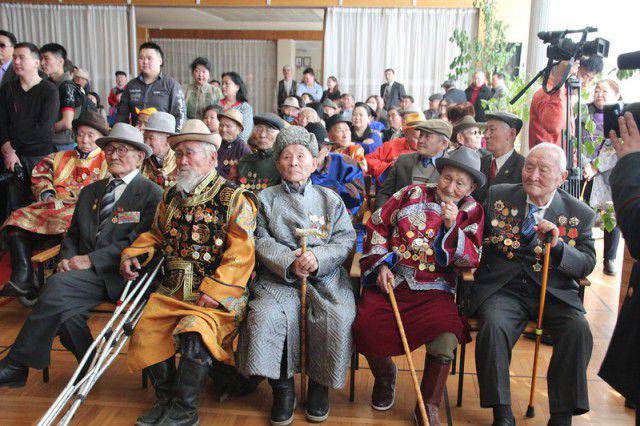
The memory of the military community of the Soviet and Mongolian peoples is preserved up to the present. For a long time, meetings of veterans of the tank column “Revolutionary Mongolia” and the aviation squadron “Mongolian arat” were organized. 9 May 2015, on the day of the seventieth anniversary of the Great Victory, was visited by a Mongolian delegation led by the current president of the country, Tsakhiagiin Elbegdorzh. The parade was attended by 80 Mongolian military personnel trained under the leadership of Colonel G. Saikhanbayar, Chairman of the Policy Planning and Strategy Department of the Ministry of Defense of Mongolia. The President of Mongolia Tsakhiagin Elbegdorzh congratulated the Russian people on the seventieth anniversary of the victory over Nazi Germany. According to Russian President Vladimir Putin, this is natural, since Mongolia throughout the Great Patriotic War really supported the Soviet Union in the fight against fascist aggression.
Photo materials from the site http://siberia-minis.7910.org/forum/showthread.php?fid=29&tid=192 were used.
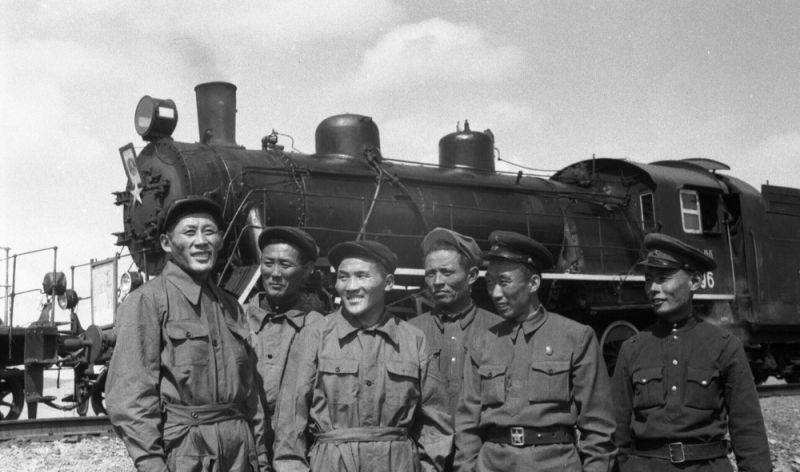
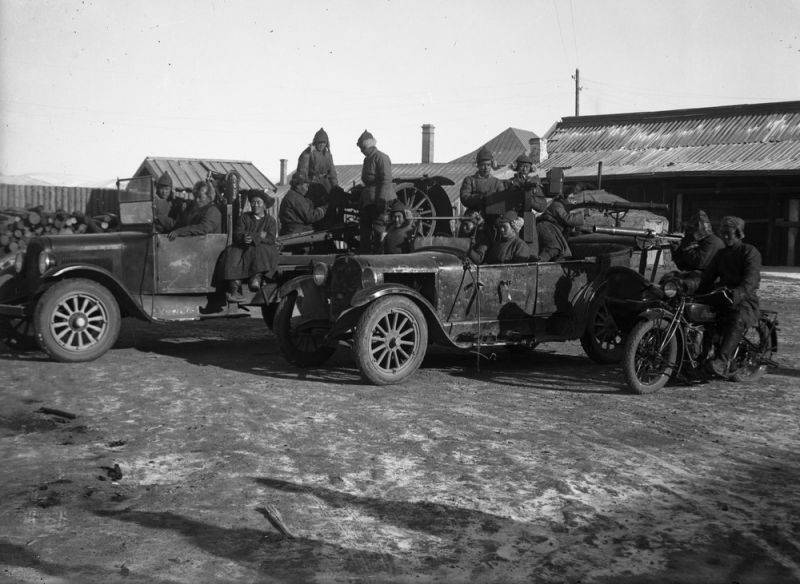
Information